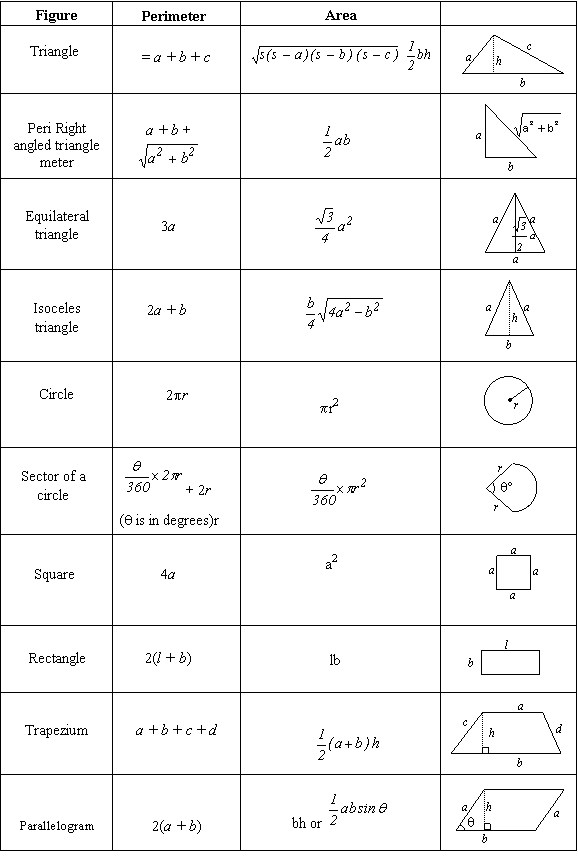
RATIO – PROPORTION – VARIATION
1. If a
: b : : c : d, then ad = bc
2. If a : b
: : c : d, then a + b : b : : c
+ d : d
3. If a
: b : : c : d, then a - b : b : : c - d : d
4. If a
: b : : c : d, then a + b : a - b : : c + d :
c - d
5. If ![]() then k =
then k =![]()
NUMBERS
1. a3 + b3 +
c3 – 3abc = (a + b + c) (a2
+ b2 + c2 – ab – bc – ca)
2. The
product of n consecutive integers is always divisible by n! (n
factorial)
3. The
sum of any number of even numbers is always even
4. The sum of even number of odd numbers is
always even
5. The sum of odd number of odd numbers is
always odd
6. If N is a
composite number such that N = ap . bq
. cr .... where a, b, c are prime
factors of N and p, q, r .... are positive integers, then
a) the number of factors of N is given by the expression (p
+ 1) (q + 1) (r + 1) ...
b) it can be expressed as the product of two
factors in 1/2 {(p + 1) (q + 1) (r + 1).....} ways
c) if
N is a perfect square, it can be expressed
(i) as
a product of two DIFFERENT factors in 1/2 {(p + 1) (q + 1) (r
+ 1) ... -1 } ways
(ii) as
a product of two factors in 1/2 {(p + 1) (q + 1) (r + 1)
... +1} ways
d) sum of all factors of N = 
e) the number of
co-primes of N (< N), f (N) = ![]()
f) sum
of the numbers in (e) = ![]()
g) it
can be expressed as a product of two factors in 2n–1,
where ‘n’ is the number of different prime factors of the given number N
SIMPLE INTEREST AND COMPOUND INTEREST
I = Interest, P is Principle, A = Amount, n
= number of years, r is rate of interest
1. Interest
under
a) Simple interest, I =![]()
b) Compound interest, I =
P
2. Amount under
a) Simple interest, A = ![]()
b) Compound interest, A =
P![]()
3. Effective
rate of interest when compounding is done k times a year
re =![]()
MIXTURES AND
ALLIGATION
1. If p1,
p2 and p are the respective concentrations of the
first mixture, second mixture and the final mixture respectively, and q1
and q2 are the quantities of the first and the second
mixtures respectively, then Weighted Average (p)
p
= ![]()
2. If C is the concentration after a dilutions, V is the original volume
and x is the volume of liquid. Replaced each time then C = ![]()
QUADRATIC
EQUATIONS
1. If a, b and c are all rational and x
+![]() is an irrational root of ax2 + bx + c
= 0, then x -
is an irrational root of ax2 + bx + c
= 0, then x -![]() is the other root
is the other root
2. If a and b are the roots of ax2 + bx + c = 0,
then a + b =![]() and ab =
and ab = ![]()
3. When a
> 0, ax² + bx + c has a minimum value equal to![]() , at x =
, at x = ![]()
4. When a < 0, ax² + bx
+ c has a maximum value equal to![]() , at x =
, at x = ![]()
PROGRESSIONS
Arithmetic
Progression (A.P)
a
is the first term, d is the last term and n is the number of
terms
1. Tn
= a + (n – 1)d
2. Sn
= ![]() =
= ![]()
3. Tn = Sn
– Sn-1
4. Sn
= A.M ´ n
Geometric Progression (G.P)
a
is the first term, r is the common ratio and n is the number of
terms
5. Tn
= arn-1
6. Sn
= ![]() =
=![]()
Harmonic Progression (H.P)
7. H.M of a
and b =![]()
8. A.M > G.M > H.M
9. (G.M)2 = (A.M) (H.M)
10. Sum of first n
natural numbers ån
= ![]()
11. Sum
of squares of first n natural numbers ån2 = ![]()
12. Sum of cubes of first n natural
numbers ån3 =![]() = (ån)2
= (ån)2
GEOMETRY
1. In a triangle ABC, if AD is the angular
bisector, then![]()
2. In a triangle ABC, if E and F are the points of AB and AC respectively
and EF is parallel to BC, then ![]()
3. In a triangle ABC, if AD is the median, then
AB2 + AC2 = 2(AD2 + BD2)
4. In parallelogram, rectangle, rhombus and
square, the diagonals bisect each other
5. Sum of all the angles in a polygon is (2n
– 4)90
6. Exterior angle of a polygon is ![]()
7. Interior angle of a polygon is ![]()
8. Number of diagonals of a polygon is ![]()
9. The
angle subtended by an arc at the centre is double the angle subtended by the
arc in the remaining part of the circle
10. Angles in the
same segment are equal
11. The angle subtended by the diameter of the
circle is 90°
MENSURATION
1. Plane figures

2.
Solids


HIGHER
MATHS – I
(PERMUTATIONS
& COMBINATIONS, PROBABILITY)
1. n (A È B) = n (A) + n (B)
– n (A Ç B)
2. If A and B are two tasks that must be performed such
that A can be performed in 'p' ways and for each possible way of
performing A, say there are 'q' ways of performing B, then the two tasks
A and B can be performed in p ´ q ways
3. The number of ways of dividing (p + q)
items into two groups containing p and q items respectively is ![]()
4. The number of ways of dividing 2p
items into two equal groups of p each is ![]() , when the two groups have distinct identity and
, when the two groups have distinct identity and ![]() , when the two groups do not have distinct identity
, when the two groups do not have distinct identity
5. nCr = nCn–
r
6. The total number of ways in which a
selection can be made by taking some or all out of (p + q + r
+ .....) items where p are alike of one kind, q alike of a second
kind, r alike of a third kind and so on is {(p + 1) (q +
1) (r + 1) ....} -1
7. P(Event) = ![]() and 0 £ P(Event) £ 1
and 0 £ P(Event) £ 1
8. P(A Ç B) = P(A) ´ P(B), if A and B are independent events
9. P(A È B) = 1, if A and B are exhaustive events
10. Expected Value =
![]() [Probability (Ei)]´ [Monetary value associated with event Ei]
[Probability (Ei)]´ [Monetary value associated with event Ei]
HIGHER MATHS – II
(STATISTICS, NUMBER SYSTEMS, INEQUALITIES & MODULUS, SPECIAL
EQUATIONS)
1. G.M. = (x1
× x2 × ...... .xn)1/n
2. 
3. For any two positive numbers a, b
(i) A.M. ³ G.M. ³ H.M. (ii) (G.M.)2 = (A.M.) (H.M.)
4. Range = Maximum value – Minimum value
5. Q.D. =![]() (i.e., one-half the range of quartiles)
(i.e., one-half the range of quartiles)
6. If a
> b, ![]() , for any two positive numbers a and b
, for any two positive numbers a and b
7. |x + y| £ |x| + |y|, for any two real
numbers x and y
8. If for
two positive values a and b; a + b = constant (k),
then the maximum value of the product ab is obtained for a = b
= ![]()
9. If for two positive values a and b;
ab = constant (k), then the minimum value of the sum (a + b)
is obtained for a = b
= ![]()
HIGHER MATHS – III
(CO-ORDINATE
GEOMETRY, FUNCTIONS & GRAPHS, TRIGONOMETRY)
1. If a point P(x, y) divides the line segment joining A(x1,
y1) and B(x2, y2) in the
ratio m : n, then x =![]() and y =
and y =![]() , positive sign for internal division and negative sign for
external division
, positive sign for internal division and negative sign for
external division
2. The area of a triangle with the vertices at
(0, 0), (x1, y1) and (x2,
y2) is D = ![]() .
.
3. The
coordinates of the centroid C(x, y) of a triangle ABC formed by
joining the points
A(x1, y1); B(x2, y2)
and C(x3, y3) are given by ![]()
4. The slope of line with points (x1,
y1) and (x2, y2) lying on
it is m = ![]()
5. If m1
and m2 are the slopes of two lines L1 and L2
respectively, then the angle ‘q’ between them is given by tanq = ![]()
6. The
equation of the x-axis is y = 0 and that of y-axis
is x = 0
7. The
equation of a line parallel to x-axis is of the form y = b
and that of a line parallel to y-axis is of the form x = a
(a and b are some constants)
8. Point slope form of a line: y – y1
= m (x – x1)
9. Two point form of a line:![]()
10. Slope intercept form of a line: y = mx
+ b
11. Intercept form of a line : ![]()
12. Two lines a1x + b1y
+ c1 = 0 and a2x + b2y
+ c2 = 0 are
(i) parallel if ![]() or m1= m2
or m1= m2
(ii)
perpendicular if a1 a2 + b1
b2 = 0 or m1 m2 = -1
13. The distance
between two parallel lines of the form ax + by +c1
= 0 and ax + by + c2 = 0 is given by 
14. If ax
+ by + c = 0 is the equation of a line, then the perpendicular
distance of a point (x1, y1) from the line
is given by 
15. sine rule : ![]() = 2R, where R is the circumradius of triangle ABC
= 2R, where R is the circumradius of triangle ABC
16. cosine rule :
cosA =![]() , similarly cosB and cosC can be defined
, similarly cosB and cosC can be defined